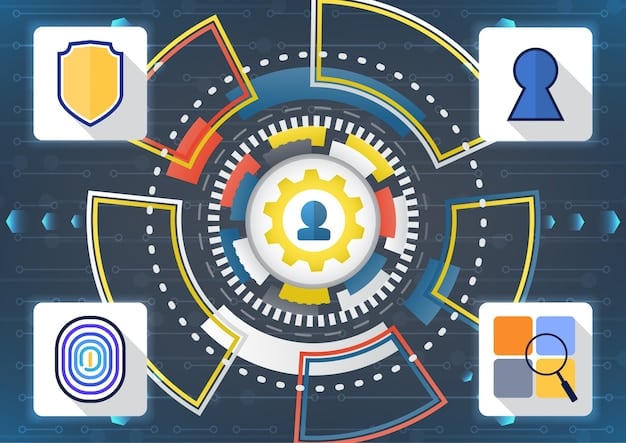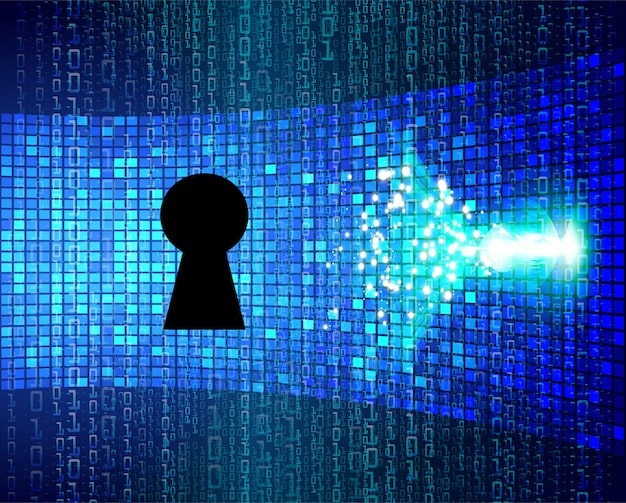NIST Cybersecurity Guidelines: Compliance for 2025

New NIST Guidelines Released: Are Your Cybersecurity Practices Compliant for 2025? The latest guidelines from the National Institute of Standards and Technology (NIST) require organizations to reassess and enhance their cybersecurity practices to effectively mitigate evolving threats and ensure compliance by 2025.
The cybersecurity landscape is constantly evolving, and with it, so must the standards and practices that protect our digital assets. The New NIST Guidelines Released: Are Your Cybersecurity Practices Compliant for 2025? This is a crucial question that every organization needs to address proactively to ensure data protection and regulatory compliance.
Understanding the Significance of NIST Guidelines
The National Institute of Standards and Technology (NIST) plays a pivotal role in developing cybersecurity standards and guidelines that are widely adopted by organizations across various sectors. These guidelines provide a comprehensive framework for managing cybersecurity risks and protecting sensitive information.
What is NIST and Why Does it Matter?
NIST is a non-regulatory agency of the U.S. Department of Commerce that develops and promotes standards and guidelines to help organizations manage cybersecurity risks. NIST’s publications, such as the Cybersecurity Framework (CSF) and Special Publications (SPs), are highly regarded and used by organizations worldwide.
Adhering to NIST guidelines can significantly enhance an organization’s cybersecurity posture. These guidelines provide a structured approach to identifying, assessing, and managing cybersecurity risks, helping organizations to implement robust security controls and protect their assets from cyber threats.

Key Benefits of Adhering to NIST Guidelines
- Enhanced Security: Implementing NIST guidelines helps organizations to establish a strong security foundation, reducing the likelihood of successful cyberattacks.
- Compliance: Adhering to NIST guidelines can help organizations meet regulatory requirements and industry standards.
- Risk Management: NIST guidelines provide a structured approach to identifying, assessing, and managing cybersecurity risks.
- Improved Resilience: By implementing robust security controls, organizations can improve their ability to quickly detect, respond to, and recover from cyber incidents.
Complying with NIST guidelines is no longer optional; it’s an essential component of modern cybersecurity practices. By understanding the significance of these guidelines, organizations can better protect themselves and their stakeholders from evolving cyber threats.
Key Changes in the New NIST Guidelines
The latest updates to the NIST guidelines reflect the evolving threat landscape and incorporate new technologies and best practices. Understanding these changes is crucial for organizations to ensure their cybersecurity practices remain effective and compliant.
The new NIST guidelines emphasize several key areas, including supply chain risk management, data security, and incident response. Organizations need to reassess their current practices and implement necessary changes to align with these updated recommendations.
Supply Chain Risk Management
Supply chain attacks have become increasingly prevalent in recent years, highlighting the need for organizations to effectively manage risks associated with their vendors and suppliers. The new NIST guidelines provide specific recommendations for assessing and mitigating supply chain risks, including conducting due diligence on vendors, implementing security requirements in contracts, and monitoring vendor compliance.
Data Security
Protecting sensitive data is a top priority for organizations of all sizes. The updated NIST guidelines include enhanced recommendations for data encryption, access controls, and data loss prevention (DLP). Organizations need to implement robust data security measures to prevent unauthorized access, use, disclosure, disruption, modification, or destruction of sensitive data.

Incident Response
Even with the best security measures in place, cyber incidents can still occur. The new NIST guidelines emphasize the importance of having a well-defined incident response plan and the ability to quickly detect, respond to, and recover from cyber incidents. Organizations should regularly test their incident response plans and ensure that their staff is properly trained to handle security incidents.
Staying informed about the key changes in the new NIST guidelines is essential for organizations to maintain a strong cybersecurity posture and protect their assets from evolving cyber threats.
Assessing Your Current Cybersecurity Posture
Before implementing any changes, organizations need to assess their current cybersecurity posture to identify gaps and areas for improvement. This assessment should involve a comprehensive review of existing policies, procedures, and technical controls.
Start by reviewing your existing cybersecurity framework to ensure it aligns with the new NIST guidelines. Identify any gaps in your security controls and develop a plan to address them.
Conducting a Gap Analysis
A gap analysis involves comparing your current cybersecurity practices against the new NIST guidelines to identify areas where your organization falls short. This analysis should cover all aspects of your cybersecurity program, including risk management, security policies, technical controls, and incident response.
Using Assessment Tools and Frameworks
Several assessment tools and frameworks can help organizations assess their cybersecurity posture. NIST offers a variety of resources, including the Cybersecurity Framework (CSF) Self-Assessment Tool, which can help organizations evaluate their alignment with the CSF. Other popular frameworks include the Center for Internet Security (CIS) Controls and the ISO 27001 standard.
- NIST Cybersecurity Framework (CSF) Self-Assessment Tool
- Center for Internet Security (CIS) Controls
- ISO 27001
By conducting a thorough assessment of their current cybersecurity posture, organizations can gain valuable insights into their strengths and weaknesses, enabling them to prioritize their efforts and allocate resources effectively.
Implementing Compliance Measures for 2025
Once you have assessed your current cybersecurity posture and identified gaps in your security controls, it’s time to implement compliance measures to align with the new NIST guidelines. This process involves developing and implementing new policies, procedures, and technical controls.
Start by prioritizing the areas where your organization is most vulnerable to cyber threats. Focus on implementing security controls that provide the greatest level of protection for your critical assets.
Developing Updated Policies and Procedures
Your organization’s cybersecurity policies and procedures should be updated to reflect the new NIST guidelines. These policies should clearly define roles and responsibilities, security requirements, and incident response procedures. Ensure that all staff members are aware of these policies and receive regular training on cybersecurity best practices.
Implementing Technical Controls
Technical controls, such as firewalls, intrusion detection systems, and antivirus software, play a crucial role in protecting your organization’s systems and data. Ensure that these controls are properly configured and regularly updated to protect against the latest cyber threats. Implement multi-factor authentication (MFA) for all user accounts and encrypt sensitive data both in transit and at rest.
Regular Training and Awareness Programs
Cybersecurity is a shared responsibility, and all employees should receive regular training on cybersecurity best practices. Conduct regular awareness programs to educate employees about phishing scams, social engineering attacks, and other common cyber threats. Encourage employees to report any suspicious activity and provide them with the resources they need to stay safe online.
Implementing compliance measures for 2025 requires a proactive and ongoing effort. By developing updated policies and procedures, implementing technical controls, and providing regular training and awareness programs, organizations can significantly enhance their cybersecurity posture and protect their assets from evolving cyber threats.
The Role of Technology in Achieving Compliance
Technology plays a critical role in helping organizations achieve compliance with the new NIST guidelines. Investing in the right cybersecurity tools and technologies can automate security tasks, improve threat detection, and streamline compliance efforts.
Consider investing in security information and event management (SIEM) systems, threat intelligence platforms, and vulnerability management tools to enhance your organization’s security capabilities.
Security Information and Event Management (SIEM) Systems
SIEM systems collect and analyze security logs from various sources to identify potential security incidents. These systems can provide real-time threat detection and incident response capabilities, helping organizations to quickly identify and mitigate cyber threats. SIEM systems can also help organizations to meet compliance requirements by providing detailed audit trails and reporting capabilities.
Threat Intelligence Platforms
Threat intelligence platforms collect and analyze data about emerging cyber threats and vulnerabilities. These platforms can provide organizations with valuable insights into the latest attack techniques and help them to proactively defend against cyber threats. By integrating threat intelligence into their security operations, organizations can improve their ability to detect and respond to cyber incidents.
Vulnerability Management Tools
Vulnerability management tools scan systems and applications for known vulnerabilities. These tools can help organizations to identify and prioritize vulnerabilities, enabling them to patch or remediate them before they can be exploited by attackers. Regularly scanning for vulnerabilities is an essential component of a comprehensive cybersecurity program.
Leveraging technology effectively can significantly enhance an organization’s ability to achieve compliance with the new NIST guidelines. By investing in the right cybersecurity tools and technologies, organizations can automate security tasks, improve threat detection, and streamline compliance efforts.
Maintaining and Monitoring Compliance Continuously
Compliance is not a one-time event; it’s an ongoing process that requires continuous monitoring and maintenance. Organizations need to establish processes for regularly reviewing their cybersecurity controls, monitoring for potential security incidents, and updating their policies and procedures as needed.
Regularly audit your cybersecurity controls to ensure they are operating effectively. Conduct penetration testing to identify vulnerabilities and assess the effectiveness of your security measures.
Regular Audits and Assessments
Conducting regular audits and assessments of your cybersecurity controls is essential for ensuring ongoing compliance. These audits should involve a thorough review of your security policies, procedures, and technical controls. Identify any gaps in your security controls and develop a plan to address them.
Penetration Testing
Penetration testing involves simulating real-world cyberattacks to identify vulnerabilities in your systems and applications. These tests can help you to assess the effectiveness of your security measures and identify areas for improvement. Engage a qualified penetration testing firm to conduct these tests on a regular basis.
- Assess the effectiveness of security measures.
- Identify vulnerabilities.
- Simulate real-world cyberattacks.
Staying Updated with Evolving Threats
The cybersecurity landscape is constantly evolving, and organizations need to stay informed about the latest cyber threats and vulnerabilities. Subscribe to threat intelligence feeds, attend industry conferences, and participate in online forums to stay up-to-date on the latest security trends. Regularly update your security policies and procedures to reflect the evolving threat landscape.
Maintaining and monitoring compliance continuously is crucial for organizations to protect their assets from evolving cyber threats. By conducting regular audits and assessments, performing penetration testing, and staying updated with the latest security trends, organizations can ensure their cybersecurity practices remain effective and compliant.
| Key Point | Brief Description |
|---|---|
| 🛡️ NIST Guidelines | Framework for managing cybersecurity risks. |
| 🔄 Key Changes | Supply chain risk, data security, incident response. |
| 🔍 Assessment | Identify gaps in current cybersecurity posture. |
| 🚀 Implementation | Update policies, technical controls, training programs. |
Frequently Asked Questions
▼
NIST guidelines are cybersecurity standards and best practices developed by the National Institute of Standards and Technology to help organizations manage cybersecurity risks.
▼
They provide a structured approach to identifying, assessing, and managing cybersecurity risks, helping organizations protect their resources and meet regulatory requirements.
▼
Conduct regular audits, gap analyses, and penetration testing to evaluate your cybersecurity posture and identify areas for improvement in alignment with NIST guidelines.
▼
The updated guidelines emphasize supply chain risk management, data security, and incident response, ensuring comprehensive coverage against evolving cyber threats.
▼
Cybersecurity practices should be updated continuously to address new threats and vulnerabilities, and policies should be reviewed at least annually or when significant changes occur.
Conclusion
Staying compliant with the New NIST Guidelines Released: Are Your Cybersecurity Practices Compliant for 2025? requires a proactive and continuous effort. By understanding the guidelines, assessing your current posture, implementing necessary measures, and making use of technology, you can protect your organization from evolving cybersecurity threats. Embrace these guidelines to ensure a secure and resilient future for your business.





